Allium spp.
I’m an equal opportunity plant lover, but there’s something extra appealing about a plant that offers a whole lot of visual impact without requiring a whole lot of work.
That’s why ornamental flowering alliums are exceptional. They make a bold, architectural statement in the garden and they’re the very definition of fuss-free.
Plus, pollinators love them and they grow well in a variety of climates, down to USDA Hardiness Zone 3.
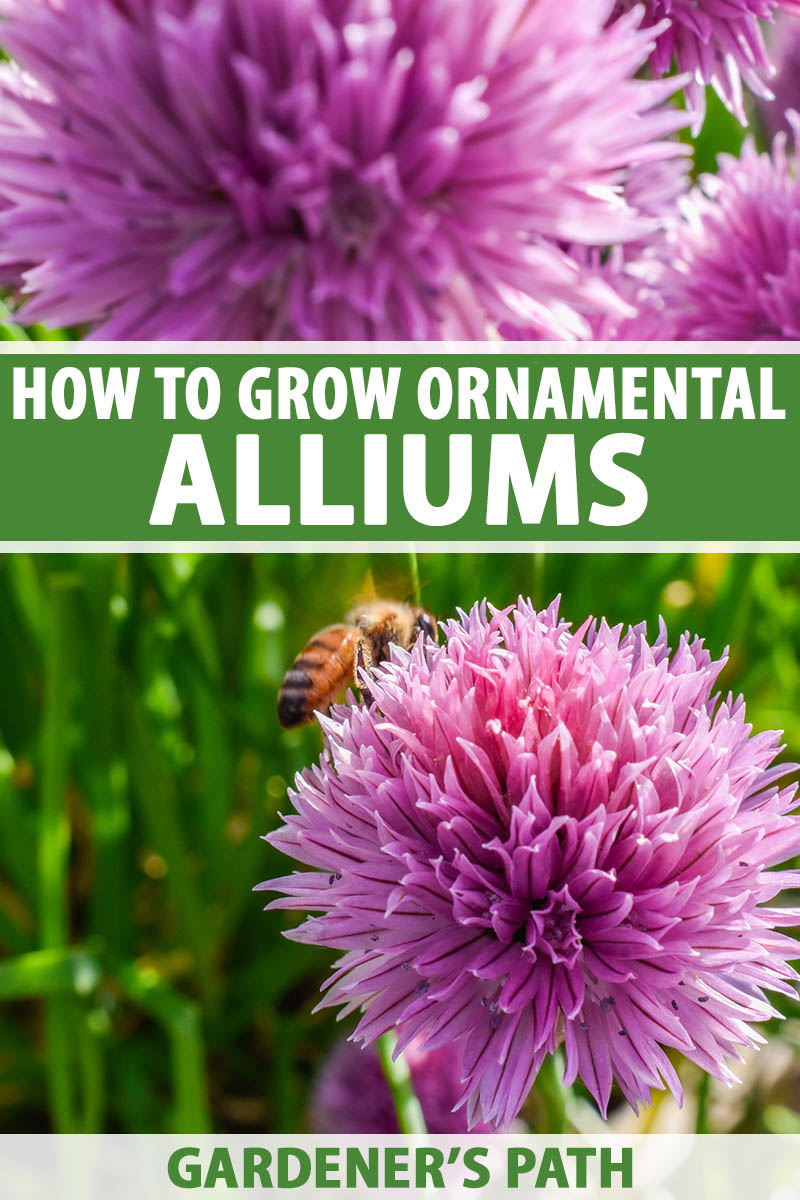
We link to vendors to help you find relevant products. If you buy from one of our links, we may earn a commission.
As if that’s not enough to recommend them, they aren’t attractive to voles, deer, and rabbits. Being part of the garlic family, they resist a lot of the common pests and diseases that may plague other flowers as well.
In spite of all these attractive features, I’d plant them even if they were fussy and positively irresistible to animals. That’s because quite frankly, they’re showstoppers.
From the massive five-foot-tall ‘Gladiator’ to the petite and lacy ‘Blue Allium,’ they all stand out like little floral fireworks in the garden.
The leaves, stalks, and flowers have a geometric look that contrasts with the more billowy, nebulous shapes that commonly fill the garden.
In fact, that’s why I’d say these plants aren’t for the shy gardener. A few of these and you’ll have the neighbors stopping by to praise your captivating display.
Are you interested in adding some ornamental alliums to your garden?
Here’s what I’ll cover:
What You’ll Learn
Although they aren’t high maintenance, they do have some specific requirements. Let’s jump in.
What Are Ornamental Alliums?
Ornamental or flowering alliums are part of the Allium genus, members of the Amaryllidaceae family that includes garlic, leeks, and onions.
If you’ve ever seen the flower of a chive plant, it’s basically a lot like that, but groomed over the ages into different shapes, sizes, and colors.
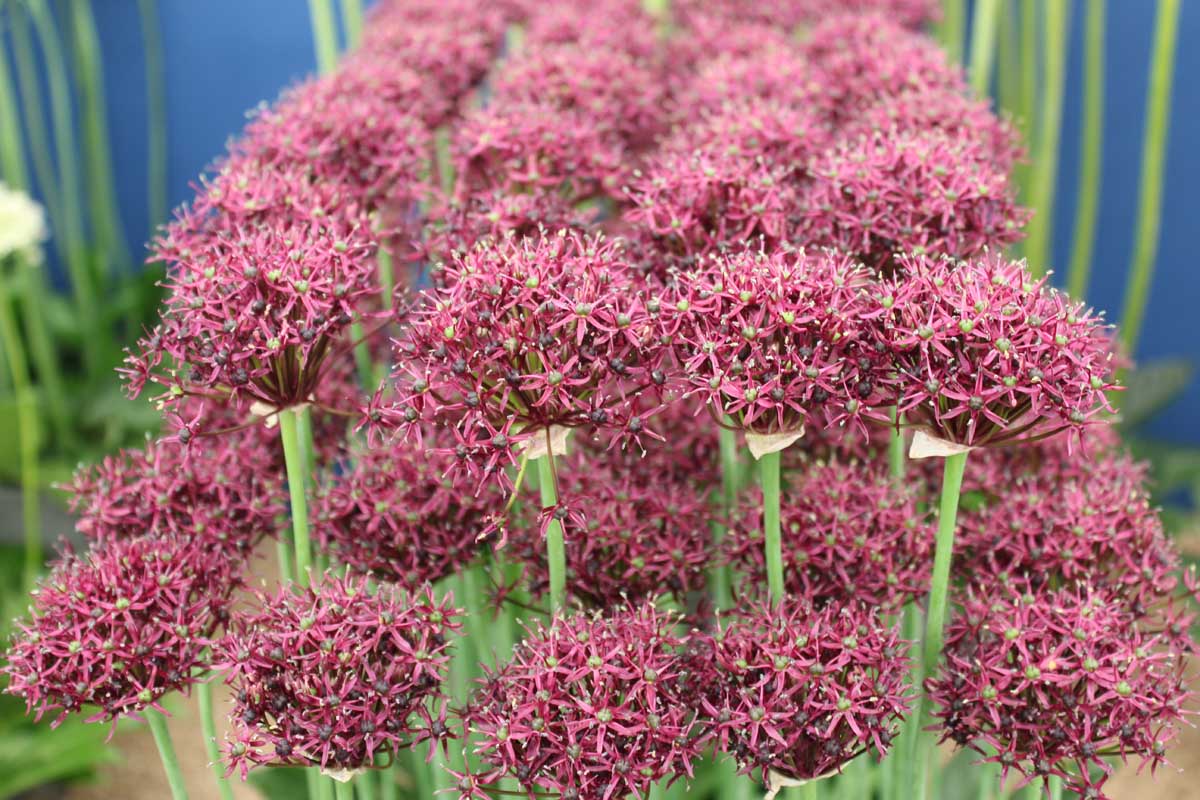
There are over 850 species of ornamental alliums, and numerous hybrids and cultivars are available.
Most ornamental alliums grow from bulbs, and that’s typically what you’ll find in nurseries and garden centers. But there are some species that are rhizomatous, such as A. angulosum, A. nutans, and A. ramosum that have small, vestigial bulbs growing from rhizomes.
The large A. giganteum, aka giant allium, grows up to four feet tall with six to eight-inch purple blooms.
A. cristophii, commonly known as star of Persia, is the parent of several ornamental allium favorites. It blooms with eight-inch violet-purple flowers atop 12 to 18-inch stalks.
A. hollandicum is a species commonly referred to as Persian onion or Dutch garlic, that features several purple cultivars. It features four-inch blooms on 12-inch scapes.
Sometimes called golden garlic or lily leek, A. moly is one of the smallest species. It grows about a foot tall and has clusters of bright yellow flowers. It can handle part shade and more moisture than other types.
The unusual rose-petalled flowers of A. schubertii burst out and away from the center with an open, star-like appearance atop 18-inch stems.
No discussion of these ornamental beauties would be complete without mentioning A. sphaerocephalon, the drumstick allium. You can learn all about them in our growing guide.
Some varieties can have a tendency to be spreaders. This is usually not a problem in cooler climates, but A. caeruleum, commonly known as “blue garlic” can spread and take over the garden in warmer locations.
For example, Naples garlic, A. neapolitanum is currently listed on California’s list of noxious weeds.
Fortunately, there are many sterile or semi-sterile hybrid cultivars available, such as ‘Millenium.’
You can learn more about how to control flowering alliums in this guide. (coming soon!)
If you are in doubt, you can contact your local extension office to find out if any species are known to cause problems in your area.
Cultivation and History
Alliums are native to parts of Europe, northern Africa, and western and central Asia.
There also are over 100 species native to North America, including A. cernum, A. stellatum (American prairie onion), and A. unifolium, and only one found in the Southern Hemisphere, A. draeganeum, native to South Africa.
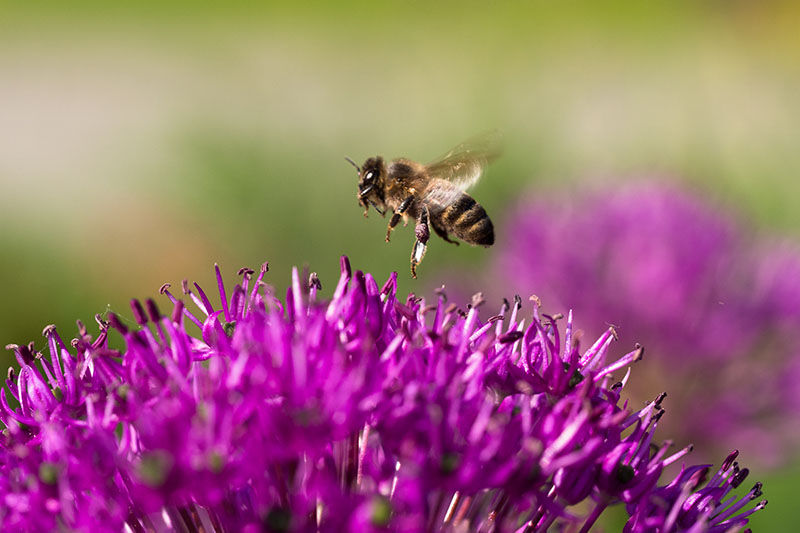
Today, they can be found growing pretty much everywhere except tropical regions and Australia.
According to R. Kamenestky and R. M Fritsch from the Department of Ornamental Horticulture at the Volcani Center in Israel, ornamental alliums weren’t commonly cultivated until the late 1800s when botanists in Europe and Russia introduced species from central and southwest Asia to European botanical gardens.
Allium Plant Propagation
All alliums, ornamental or not, can be propagated from seed, bulbs, or by division. Starting from seed requires patience, as they typically won’t bloom for at least a year or two, if not more in some cases.
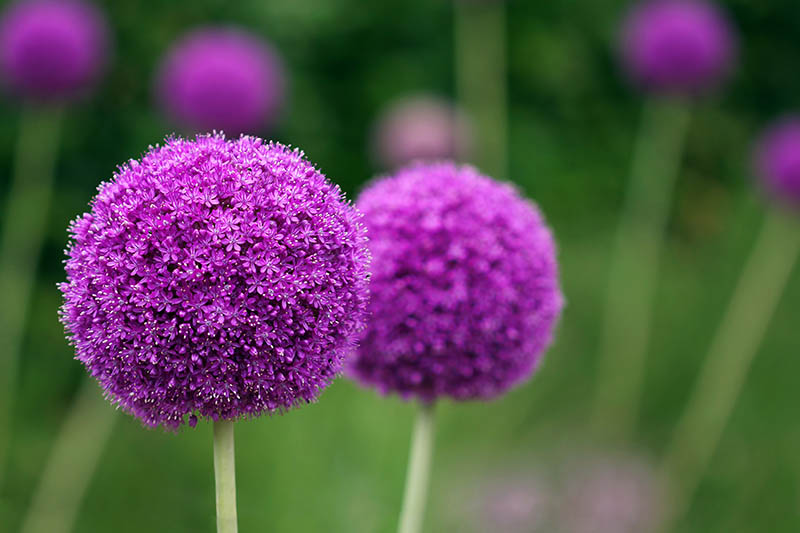
Also keep in mind that if you save seeds from plants in your garden, they may not grow true to the parent plant if it is a hybrid variety.
Give these gorgeous bloomers well-draining, slightly sandy soil. They don’t do well in heavy clay, so work in some sand to improve drainage if that’s what you have in your yard.
You may also want to conduct a soil test to determine if you need to work any amendments into the soil.
Flowering alliums don’t demand much beyond well-draining soil, but if your earth is seriously depleted in any of the big three nutrients – nitrogen (N), phosphorus (P), or potassium (K) – you’ll want to correct any deficiencies.
From Seed
You can purchase seeds or plant those that you saved from the previous season (more on that below).
In the spring, after all risk of frost has passed, loosen the soil and sprinkle the seeds over the area where you want your plants to grow. The seeds are small, so don’t bother sowing them carefully one by one. Just broadcast them liberally around the growing area.
Cover the seeds with 1/4 inch of soil and water well using the soaker attachment on your hose so you don’t disturb them. Keep the soil moist until you see the first green sprouts pop up. Then you can reduce watering to allow the top inch of soil to dry out slightly in between.
Thin the plants to the recommended distance for spacing described on your seed packet once they emerge. Alliums come in a variety of sizes and have different space requirements.
By Division
Dividing your allium plants is a fall chore. Every three to four years, it’s a good idea to divide your plants to keep them healthy and ensure that they are well-spaced.
The first step is to cut back the flower heads and any foliage that remains at the end of the growing season, four to six weeks before the first frost.
Dig down nine inches, allowing a six inch margin around each plant. Ornamental alliums don’t have deep roots, but you want to avoid disturbing them too much.
Keep in mind, as mentioned, alliums can either grow from bulbs or rhizomes, but the process for digging them up and dividing them is similar.
Using your shovel, lift up the clump of dirt and gently tease out the bulbs or rhizomes.
Separate the bulbs and place one of them back where it was growing, at the same depth that it was planted to before you dug it up. Work in a little bulb fertilizer along with the soil if you haven’t fertilized your plants in several years.
To divide rhizomes, slice the rhizome in half using a sharp knife. Put one half of the rhizome back in place at the same depth it was growing.
Take the excess bulbs and plant them as you would new bulbs or transplants, which we cover in the next section.
If you can’t plant right away, store the bulbs in a cool, dark spot for a few months. Rhizomes can be stored in a plastic bag in the fridge for a week or so.
Planting Bulbs or Rhizomes
Whether you buy bulbs at a local retailer, online, or obtain some from a friend or by division, the planting process is all the same.
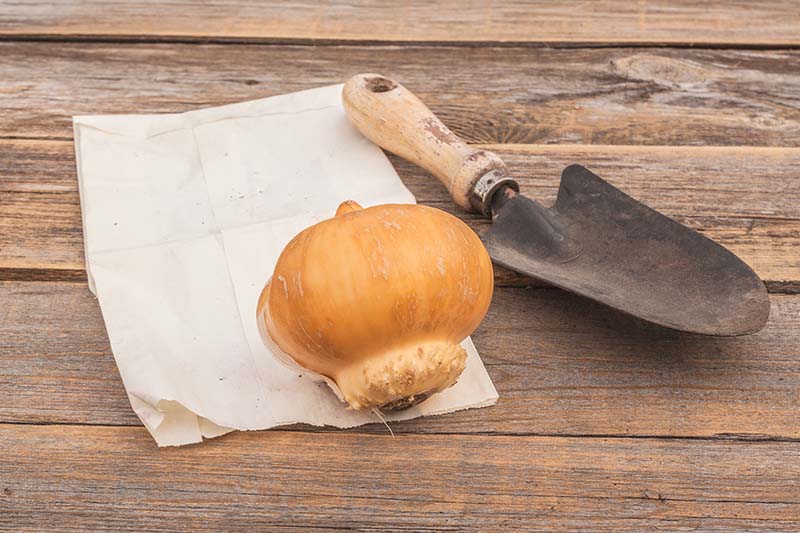
If you haven’t done a soil test, be sure to get one done in the late summer before planting, to check if any amendments are indicated.
In the fall, six to eight weeks before first frost, loosen up the earth using a fork or shovel.
Work in some bulb fertilizer like Jobe’s Organics Bulb Fertilizer, available at Amazon, if desired.

Jobe’s Organics Bulb Fertilizer
This fertilizer is specifically formulated not to burn the bulbs of the plants.
You want to place bulbs with the pointy ends facing up about three times as deep as the bulb is long – typically four to eight inches.
If you’re planting rhizomes, you should follow the grower’s recommendations for depth and make sure the shoots are facing up.
Space them according to the specific recommendations for your selected species or cultivar. This typically ranges from four to 12 inches. Cover with soil and water well.
How to Grow Ornamental Allium Flowers
Most alliums like lots and lots of sun, at least six hours of direct sunlight a day. However, some species do better with a bit of shade, particularly in the heat of the afternoon. All varieties will tolerate partial sun.
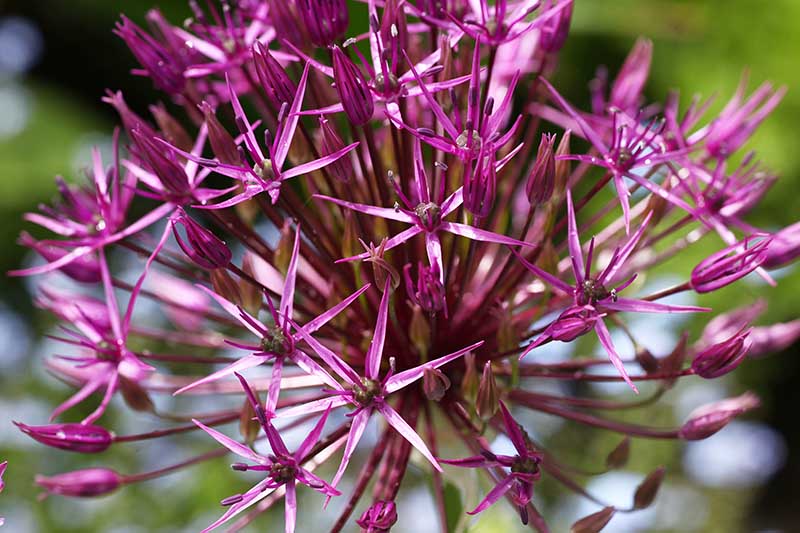
Almost all flowering alliums are happiest when they get a moderate amount of water. You want to let the top inch or two of soil dry out in between watering.
When in doubt, you should err on the side of too dry rather than watering too much. Ornamental alliums can handle drought, but wet feet cause the bulbs to rot and kill them pretty quickly.
Rhizomatous species can typically tolerate a bit more moisture.
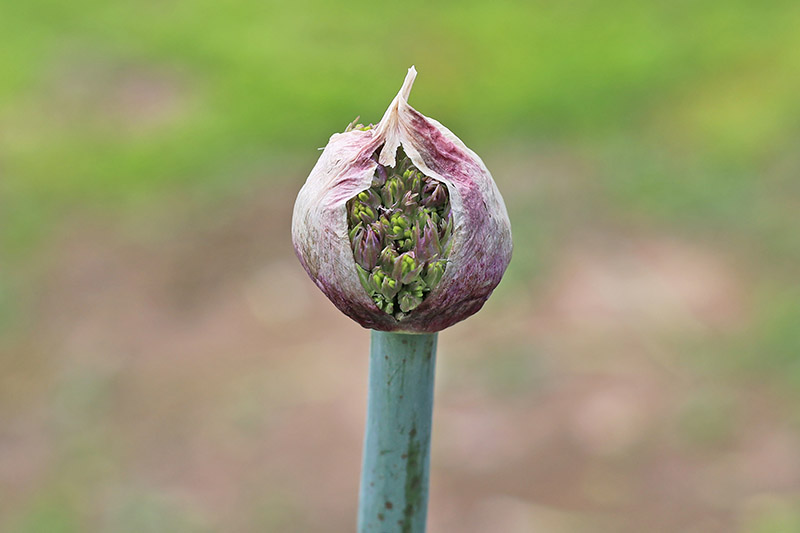
You can also plant them in containers. You’ll need a pot that’s at least 12 inches deep. The width will depend on the variety you choose and how many bulbs you wish to plant. Make sure that there are at least three or four drainage holes at the bottom of the container.
Fill with well-draining potting soil, and plant each bulb three times as deep as the diameter of the bulb. Keep in mind that containers tend to dry out more quickly than garden soil, so you may need to water more frequently.
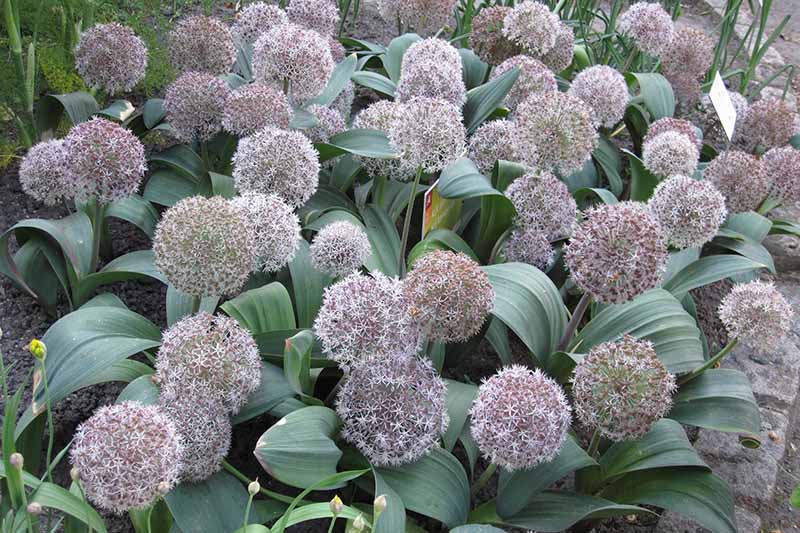
The time of year and the length of time that your plants will flower will depend on the variety. There are some cultivars, like ‘Jeannine,’ which start blooming in the early spring. Others, such as ‘Ozawa,’ won’t bloom until September.
For varieties that grow very tall and have large flower heads, you might want to provide some support, like a stake or tomato cage.
The support should reach at least halfway up the expected mature height of the flower stalk. It’s best to put this in place at planting time to avoid damage to the foliage or roots when the plant is established.
Growing Tips
- Plant in full sun or part shade, depending on the variety.
- Allow the soil to dry out slightly between waterings. Flowering alliums can handle a short period of drought.
- Provide support for tall varieties or those with large flower heads.
Maintenance
The foliage of bulb alliums dies back just before the plant blossoms. When this happens, you can snip away the dead leaves to improve air circulation and tidy up the garden.
Rhizomatous alliums typically retain their foliage until the fall. After it has died back, you can cut the dead foliage down to the ground.
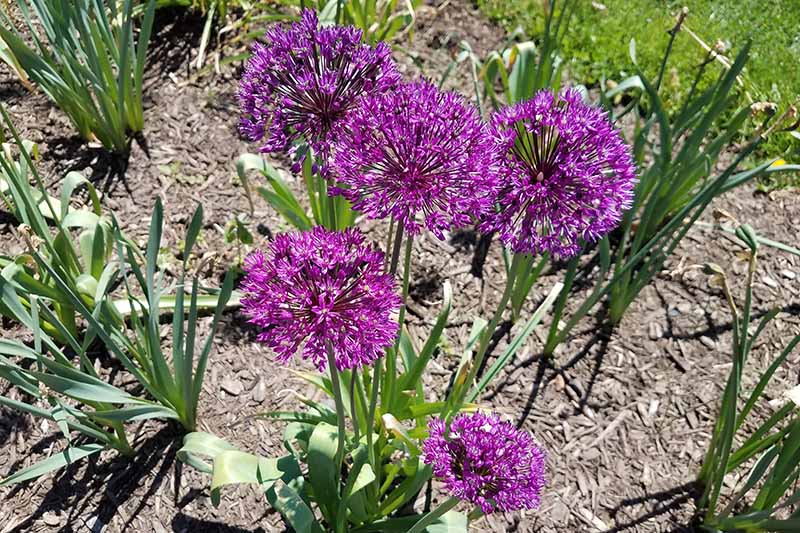
To prevent reseeding, cut off the flower heads in the fall when they turn dry. You can either feed the seeds to the birds, toss them, or keep them to give to friends or to plant new alliums.
To harvest seeds, wait until the flower heads have dropped their petals and the seed pods are plump and have turned a dull green color.
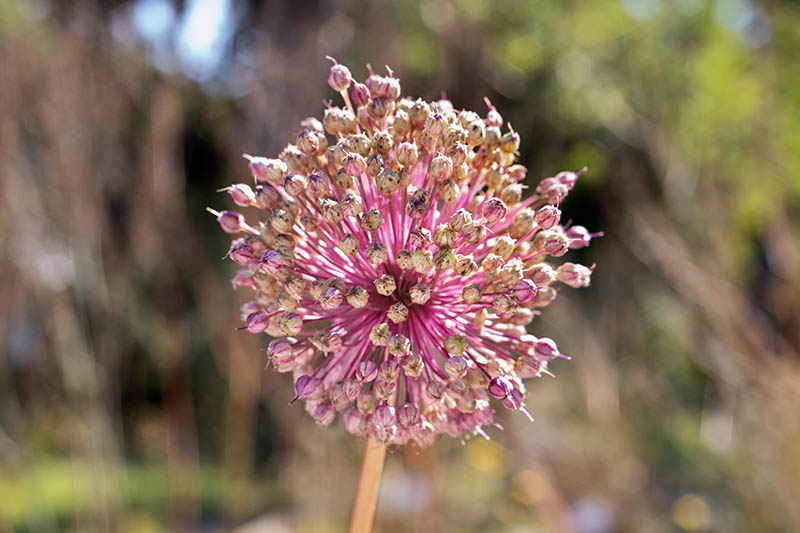
At this point some of them may be starting to split open. Cut off the flower head, place upside down in a paper bag, and hang in a cool, dry location.
As they dry out, the pods will open and release the seeds. Separate the seeds from the debris and store.
Alternatively, you can rub them between your hands and then blow the chaff away.
The seeds can be stored in a sealed bag or container in a cool, dark spot. They can remain viable for up to two years. Don’t forget to label your seeds with the date and the variety.
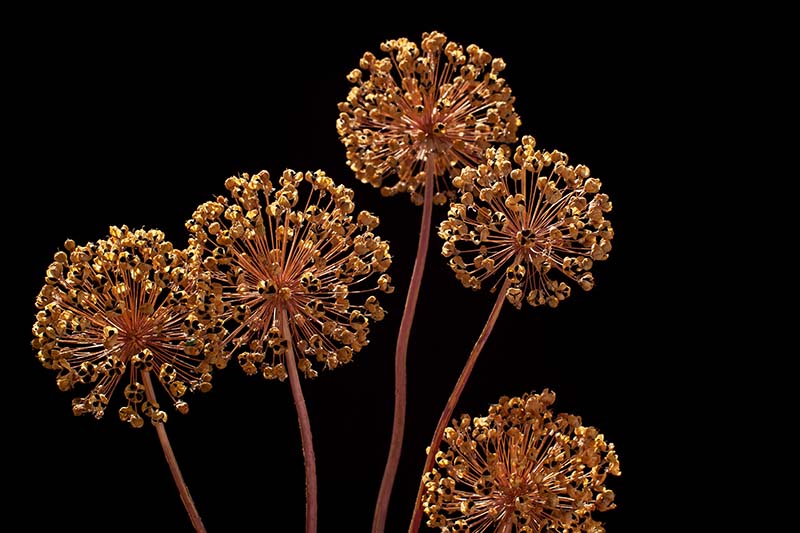
You can also simply leave the seed heads in place. They add a unique visual element to the autumn garden.
In the fall, once the seed heads are spent and the foliage has all died back, you can cut the plants to the ground. It’s not necessary for plant health, but it makes spring cleanup easier and it looks more tidy.
In the spring, trim back any dead foliage if you haven’t already. This helps give your plants good air circulation.
As mentioned, you should plan to divide your plants every few years to ensure they have adequate spacing for airflow and won’t compete for water or nutrients.
Allium Species and Cultivars to Select
Since alliums flower at different times, consider planting some early, mid-season, and late-blooming types so you can enjoy their vibrant blooms in your garden all season long.
Here are some standout varieties:
Blue Onion
‘Blue Onion’ (A. caeruleum) has striking, loose clusters of vivid blue flowers. It grows to be a little over a foot tall and blossoms in the early spring.
This type prefers a bit of shade.
You can find bulbs for your garden available at Eden Brothers.
Drumstick
If you ever played an imaginary drum set when you were a kid, then drumstick alliums (A. sphaerocephalon) are sure to delight. They’re shaped like those mallets that drummers use on cymbals and toms.
The floral heads start out green and gradually transition to reddish-purple.
Plants grow to about 18 inches tall. Grouped in a cluster, they make a statement in the garden that is hard to match.
They’re some of the later types to bloom, starting in early summer.
Find bulbs for this striking garden addition from Eden Brothers.
Globemaster
If you really want to ramp up the wow factor in your garden, ‘Globemaster’ is pretty hard to top. It’s a hybrid cross between A. cristophii and A. macleanii.
If you’ve ever witnessed a garden full of the massive purple pincushions swaying together in the breeze, it’s a sight you won’t forget.
Because they’re so large, you can use them as a focal point, planted with a variety of other low-growing plants. This helps to hide the “bare ankles” after the foliage dies back, as well.
They have sterile seeds, so they won’t spread on their own, and you can divide the clump every few years for more plants.
The majestic seven- to eight-inch purple heads grow on three to four-feet stalks and stick around from early spring to midsummer. They have an intense, sweet scent.
You can find bulbs available from Eden Brothers.
Moly
With bright yellow blooms, A. moly ‘Moly’ tops out at about a foot tall. A late-flowering variety, it will continue to provide color well into the fall.
You can find bulbs to plant in your garden available at Burpee.
Mont Blanc
This massive cultivar (A. giganteum) grows up to four feet tall with snowy white flower heads that are an impressive three inches wide, and resemble a beautiful ball of lace standing above the other plants in your garden.
You can find bulbs available at Eden Brothers.
Pinball Wizard
‘Pinball Wizard,’ a hybrid of A. cristophii and A. macleanii is aptly named. The blossoms on this plant look like magical clusters of tiny purple pinwheels.
It’s similar to ‘Globemaster’ in size, color, scent, and bloom time.
This cultivar produces sterile seed.
You can find packages of bulbs available from Eden Brothers.
Purple Sensation
All alliums are relatively undemanding in the garden, but ‘Purple Sensation’ (A. hollandicum) is even more so.
Give it full sun and well-drained soil, and you won’t have to think about it much again except to enjoy the lovely purple blossoms.
It flowers May through June on three-foot stalks.
You can find bulbs available at Eden Brothers.
Schubertii
A. schubertii ‘Schubertii’ is a standout thanks to the arrangement of the petals that burst out and away from the center to resemble an explosive sparkler. This species is not reliably cold hardy.
It grows to about 20 inches tall and doesn’t mind a little shade.
Make this species a part of your garden or cut-flower displays by grabbing some bulbs from Eden Brothers.
Managing Pests and Disease
Flowering alliums are fantastic in that instead of needing to worry about battling pests and disease all season long, you can sit back in your hammock and enjoy the display.
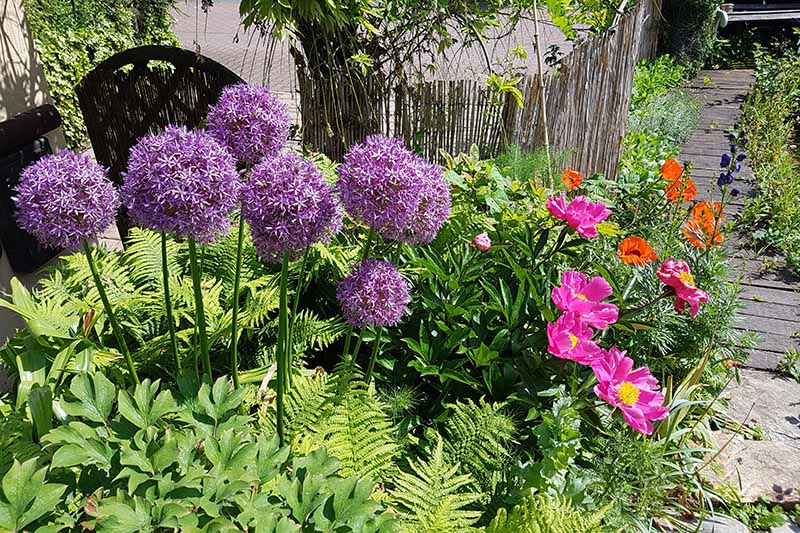
Deer, voles, rabbits, and other garden critters not only give these stunning plants a hard pass, but they are actively repelled by them.
That doesn’t mean they don’t have any problems at all, though. Here are a few things to keep an eye out for:
Insects
There are at least two types of bugs that have evolved to devour onion plants. Leafminers and onion thrips will both happily make a meal of your ornamental alliums.
Allium Leafminers
Gardeners in Europe are more familiar with this pest than those in the US. In fact, if you live in the Midwest, the West, or the South, you don’t have to worry at all. So far, the only confirmed areas that have this pest are New England, Pennsylvania, and Maryland.
The allium leafminer (Phytomyza gymnostoma) is an awful pest for people growing edible alliums. For the ornamental grower, they mostly cause surface damage.
Leafminers are the larvae of flies that have clear wings and yellow heads. The adults lay their eggs in the spring and fall. Once they hatch, the white or cream-colored larvae start chewing winding tunnels through your lovely allium leaves.
An infestation of enough of these little nibblers can stunt plant growth or cause the foliage to become curled or twisted. The good news is that the leaves of many ornamental alliums naturally die back just before the plant blossoms.
That means that unless your plant is severely damaged, with extensive tunneling in each leaf, the problem may go away on its own and your plants will still provide you with showy blossoms.
You still want to control these pests if you spot them because they create conditions that invite fungi to attack your plant. Plus, if you don’t try to stop them, it’s likely they’ll return in even larger numbers next year.
If you do find that these are a problem in your garden, you can put down silver reflective mulch in the spring. Then, place yellow sticky traps six inches above the ground and within a foot or two of your plants. These traps will help capture the adult flies as they buzz around.
In addition to, or instead of sticky traps, you can also make your own water trap to catch the adults.
To do this, put a few drops of dish soap in a cup of water and place it in a shallow bowl. Place the bowl near the base of your plants. The flies will land on the water and drown. Change the water every few days.
If all this fails, a spinosad-based insecticide is a good option.
Monterey Garden Insect spray, available at Arbico Organics, can be sprayed on foliage as a biological control, according to package instructions.
Onion Thrips
Onion thrips (Thrips tabaci) are tiny insects that are one and a half millimeters long, with two sets of wings. You probably won’t be able to get close enough to see, but the clear wings are covered in long hair.
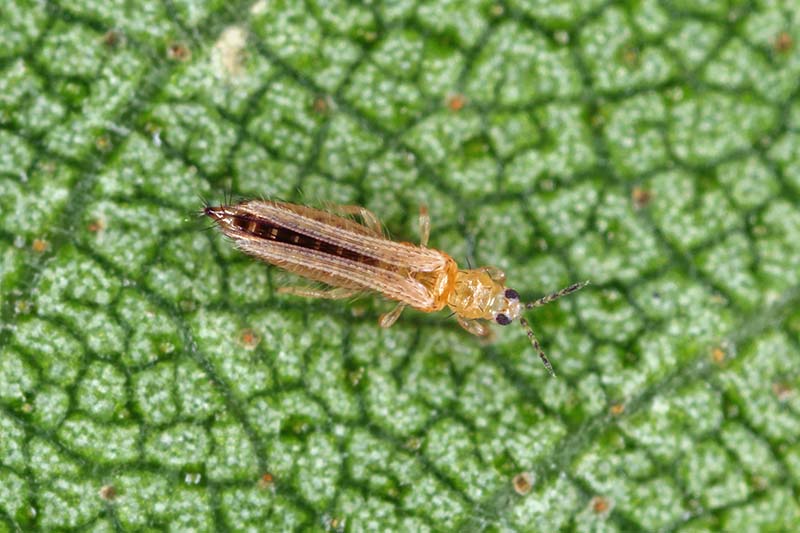
The adults are light yellow or brown, and the immature thrips are slightly smaller, but the same color. They don’t have any wings, and they thrive in dusty and dry conditions.
Both the adults and nymphs eat the leaves and bulbs of allium plants. This damage can stop your plant from flowering.
This is where you want to be sure that you’re encouraging beneficial insects to live in your garden.
Predator mites, pirate bugs, and lacewings make quick work of the adults and nymphs.
BotaniGard Beauveria bassiana is a fungal-based insecticide, available from Arbico Organics, that you mix with water and apply to your plants.
Note that it reacts to UV light, so it needs to be applied in the evening or on a cloudy day.
Disease
All alliums, including the ornamental varieties, can be troubled by a few types of fungi and water molds.
Downy Mildew
The water mold (oomycete) Peronospora destructor, causes downy mildew on plants in the allium family.
If your plants are infected, their growth will be stunted, and the foliage will turn light green or yellow. Leaves may even turn brown and die.
Sometimes, but not always, you’ll see white, furry growth on the leaves. You might also see violet lesions.
To thrive, this disease needs cool temperatures and high humidity. That’s because the spores travel through the moist air – they start to die off when air temperatures reach 75°F.
We can tackle the issue by being sure to water at the base of plants at the soil line, rather than on the foliage. You should also water early in the day so plants have time to dry out before nightfall.
Be sure to plant with appropriate spacing for your selected species or cultivar, and remove any weeds to ensure plants have adequate air circulation to prevent the build up of humidity.
White Rot
White rot is caused by the fungus Stromatina cepivorum. This disease attacks garlic, onions, leeks, and ornamental alliums. It thrives in air temperatures between 50 and 75°F.
Underneath the soil, the roots and bulbs turn black and rot away. Aboveground, the foliage turns yellow and dies.
Unfortunately, this disease is bad news. It can live in the soil for decades and there is no cure once your plants are infected. You’ll need to pull them and dispose of them in the trash.
After you’ve pulled your plants, don’t plant anything in the allium family in the same location for at least 15 years, unless you sterilize your soil first.
The best way to sterilize soil in the home garden is by solarization. This involves putting a piece of four- to six-millimeter transparent plastic over the soil during the heat of the summer. Let it sit there for at least six weeks.
Underneath the plastic, the soil heats up, which will kill off most pathogens. Keep in mind however, that this includes killing the good soil microbes – when you replant, be sure to work in some compost to help boost the soil.
Best Uses for Ornamental Allium Flowers
Flowering alliums are incredibly versatile ornamental plants.
They attract pollinators and birds, which is always a benefit in the garden.

On top of that, while the flowers can smell heavenly, the leaves have a distinctly oniony scent. As mentioned, most mammals – like rabbits, deer, and voles – will actively avoid them.
Given that the plants don’t have a large footprint, they’re perfect for those areas where you want to add a pop of color to the garden but don’t have a ton of space. They’re particularly attractive in containers.
The taller varieties are perfect for adding some height amongst lower growing plants. I particularly love to add them to my veggie garden among my carrots and beets to add some visual interest.
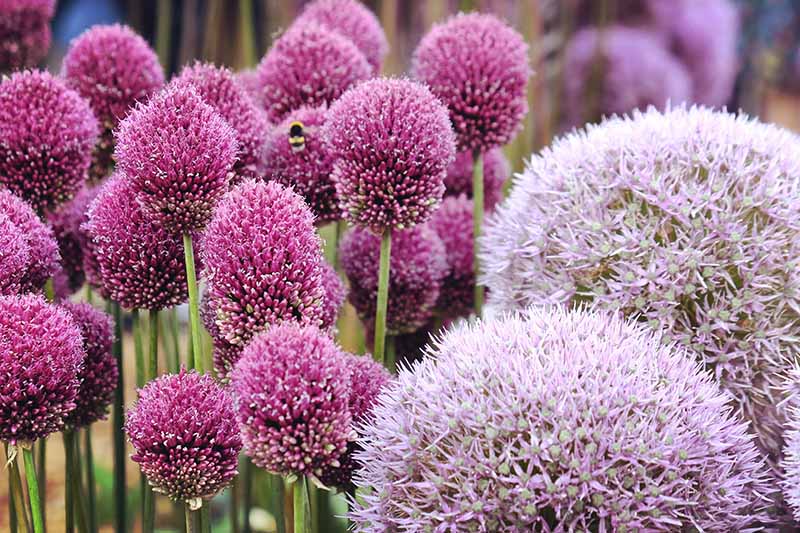
The biggest drawback to these beauties, in my opinion, is that they can look a little stark when the foliage dies back.
To remedy this, simply plant them with some leafy companions like peonies, hostas, or hardy geraniums, to obstruct your view of the lower part of the stalks.
Beyond adding a geometric element to your garden space, the flowers can enrich your home, as well.
The cut blossoms are dramatic in a cut flower display, either alone or with flowers and foliage that have contrasting shapes and colors.

In a vase with water, they can last several weeks. Read our article on making your own cut flower food at home and extending the life of cut arrangements for tips.
You can dry the flowers if you want to keep them around even longer.
To do so, snip them at your desired length and hang them upside down singly or in small groups. The easiest way to do this, I find, is to secure the ends with twine or a rubber band and hang it from a hook.

The blossoms need to dry for about a month or so, until they feel dry to the touch.
When they are dry, use them as is, or you can spray paint the flowers any color you want to make a modern addition to your home decor.
Finally, I know what you’re wondering… can you eat ornamental alliums? Absolutely. There are just two things to note:
First, don’t eat them if they – or plants growing nearby – have been sprayed with chemicals.
While gardeners often remember to be careful when spraying plants in the veggie garden, we sometimes forget when it comes to ornamentals.
Second, don’t expect the same wonderfully complex flavor you get from leeks or onions.
While you can eat the bulbs, leaves, stems, and flowers, you might want to taste them first. Some are bitter, others have notes of garlic or onion.
My favorite way to use the flowers is to snap off the petals to add a little color to salads, or you could use them as a garnish in a variety of dishes.
Quick Reference Growing Guide
| Plant Type: | Perennial flowering bulb/rhizome | Flower / Foliage Color: | Blue, crimson, green, red, pink, purple, white, yellow/green |
| Native to: | Europe, North America, northern Africa, western and central Asia | Maintenance: | Low |
| Hardiness (USDA Zone): | 3-9 | Soil Type: | Sandy, loose |
| Bloom Time: | Spring, summer, fall depending on variety | Soil pH: | 5.5-6.5 |
| Exposure: | Full sun, part shade | Soil Drainage: | Well-draining |
| Spacing: | 4-12 inches, depending on variety | Attracts: | Bees, birds, butterflies |
| Planting Depth: | 1/4 inch (seed), 3x length of bulbs | Companion Planting: | Beets, carrots, chamomile, foxglove, geranium, grasses, hosta, peony, roses |
| Height: | 1-5 feet | Uses: | Specimen plants, cut flowers, dried flowers |
| Spread: | 1-2 feet | Order: | Asparagales |
| Time to Maturity: | 2 years from seed, plant bulbs in fall for spring and summer maturity, depending on variety | Family: | Amaryllidaceae |
| Water Needs: | Low to moderate | Genus: | Allium |
| Tolerance: | Frost | Species: | atropurpureum, caeruleum, christophii, giganteum, hollandicum, moly, oreophilum, rosenbachianum, sphaerocephalon, schubertii |
| Common Pests: | Allium leafminers, onion thrips | Common Diseases: | Downy mildew, white rot |
Mild-Mannered Ornamentals That Make a Big Impression
Alliums are favored by landscapers for a good reason. They have a unique visual impact that requires relatively little effort.
Whether you use them as a border plant in a sun-filled spot, or as a focal point among some leafy hostas in dappled shade, they’re sure to stand out.

They’re in it for the long haul, too. The blossoms last for weeks and weeks, and the dried flower heads stick around beyond that. Without much work on your part, they’ll return season after season.
Are you growing flowering alliums in your garden? Let us know in the comments below, and feel free to share a picture!
And for more information about more flowering bulbs to grow in your garden, check out these guides next:


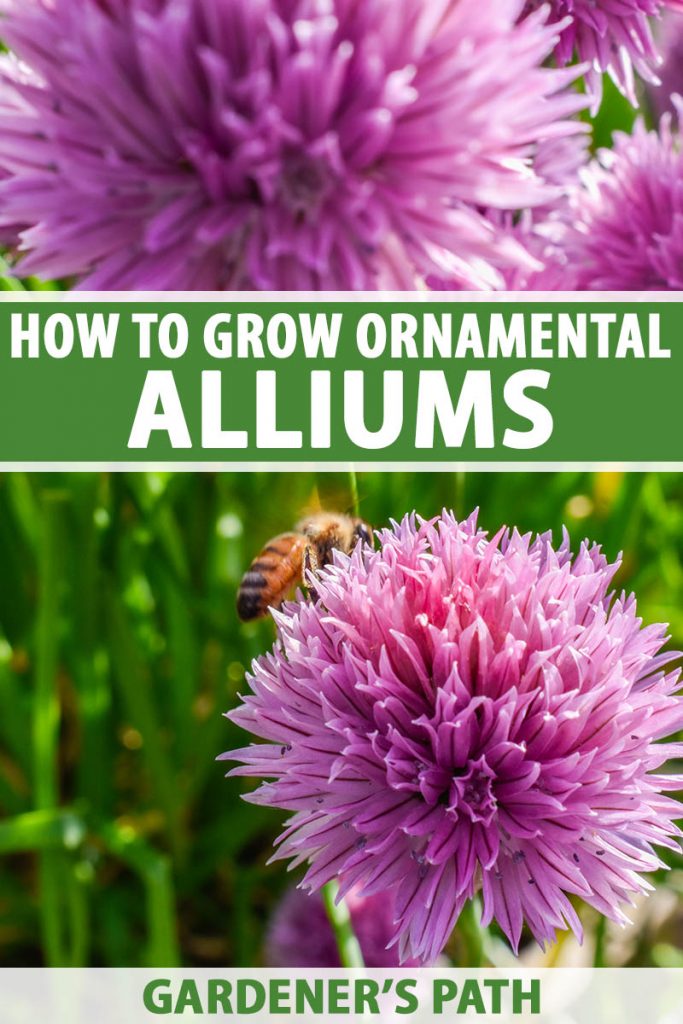

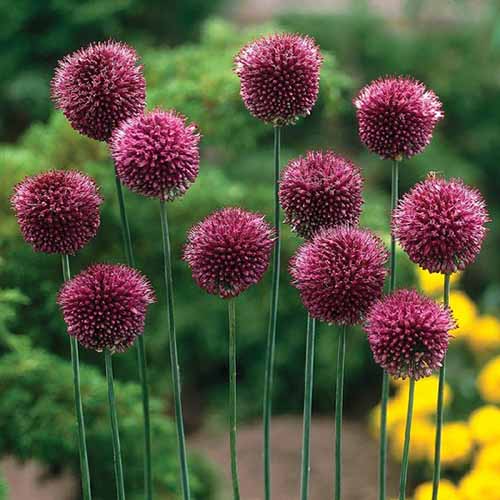
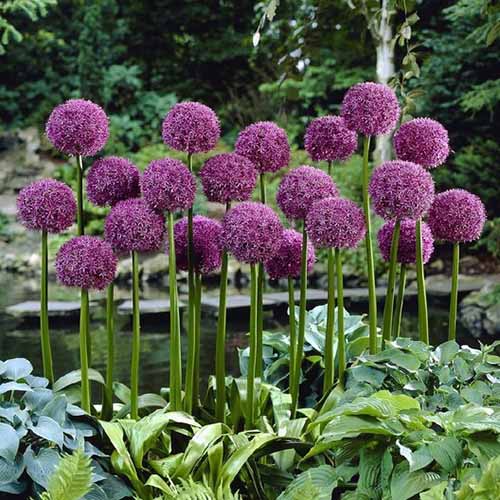

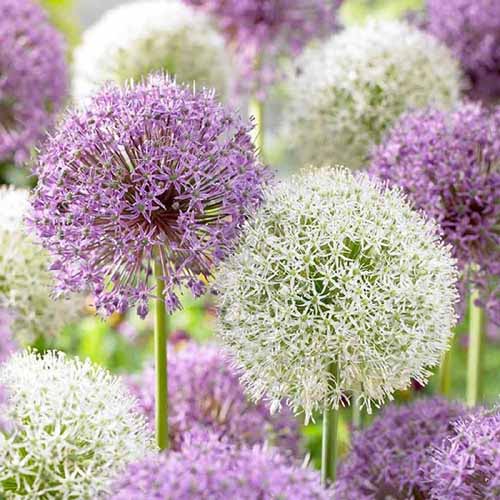
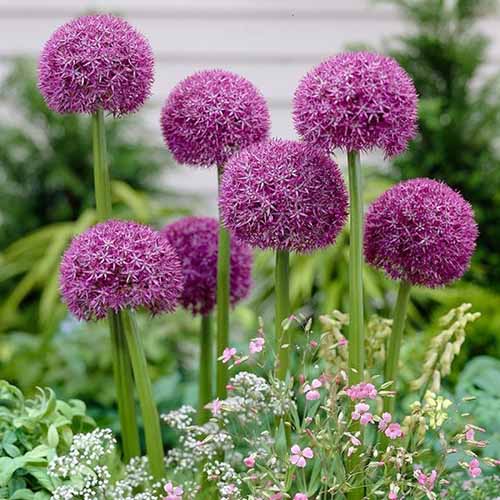
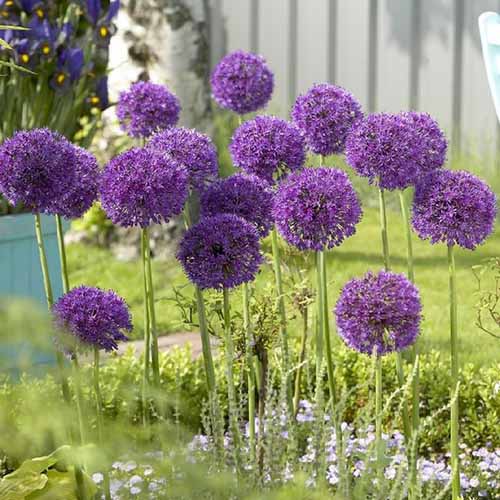

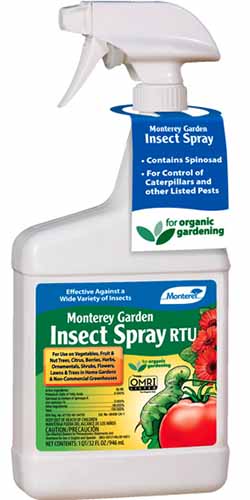
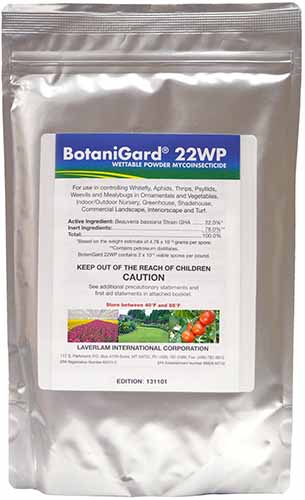

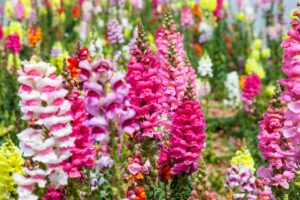
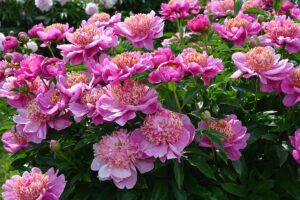
Beware, some of these alliums can become real pests in sandy soils. After they’ve been down for a while, the bulbs divide and get smaller, until they are too small to bloom, but still make foliage like turf.
Hello Robert – Thank you for raising a very good point. Many alliums are vigorous self-sowers that form a thick mat of roots and tiny bulbs that remains long after the flowers have dwindled. When selecting plants, it’s good to check with the local agricultural extension to avoid varieties that are likely to be invasive in a particular region. Deadhead plants that drop seed and choose cultivars that are infertile to minimize self-sowing.
RJ, to stop that problem divide your alliums every 36- 48 months.
Now wild garlic is a different story, burn that one in a hot fire.
I have a friend having problems with her Allium (at least that’s what I told her it was from my online research.) It’s growing curly and wants to lie on the ground…I’m not much of a gardener myself, but I was still pretty sure it was an allium before going online and pretty sure she just had them in the wrong spot…against a fence that runs along the side if the house. There’s just a narrow walk way with some plantings on either side, but definitely not a wide open space. From what I’ve read on the web, I’m thinking… Read more »
Hi Kathy! Thank you for your question and for providing photos. That’s definitely an allium flower, and it does look like it needs more sun. While some alliums can tolerate part shade, one of the main reasons the flowers flop over like that is lack of sunlight. This is because the stems strain toward the light and get extra leggy too quickly, resulting in a weaker stem that can’t hold up the flower. (I’ve had this happen while using grow lights indoors with several types of seedlings!) The good news is that you can move this allium into the sunshine… Read more »
Something or someone snapped off the tops my Allium flowers that were about to bloom.
Will they be ok next year?
Not to worry, they’ll still return next year and should still blossom.